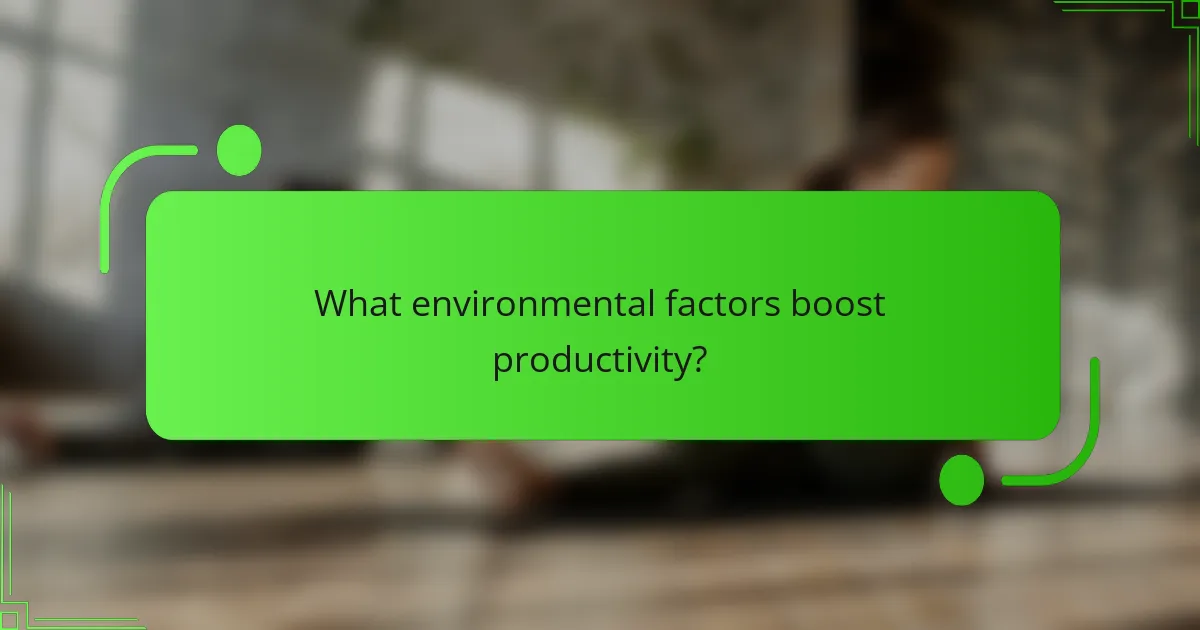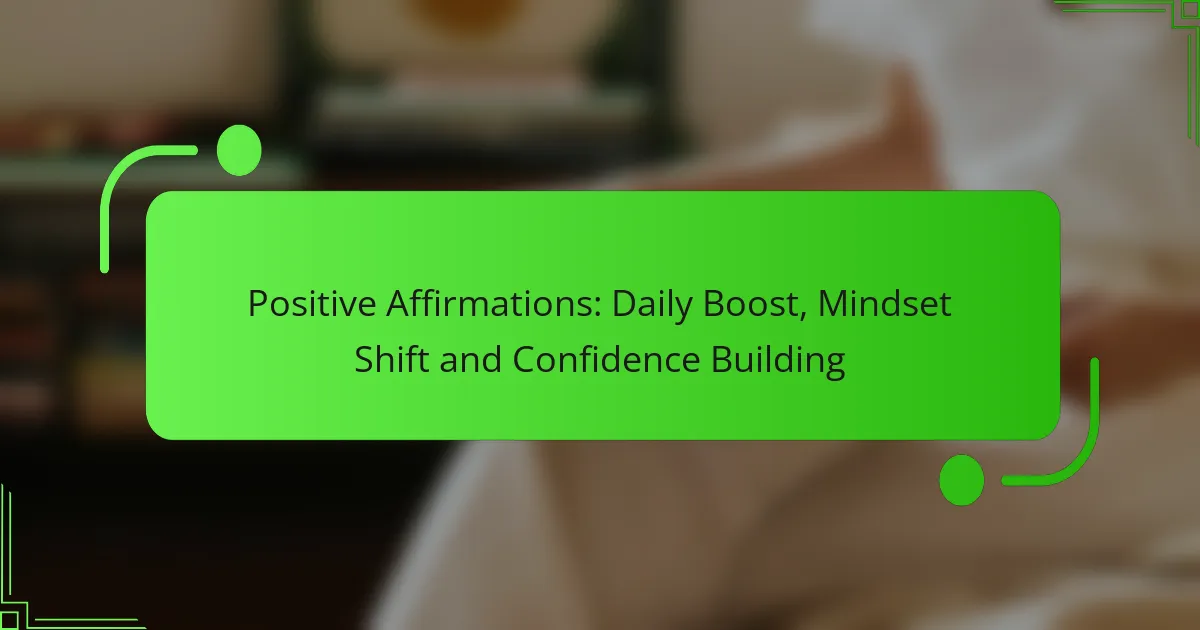The environment plays a crucial role in shaping motivation levels, productivity, and overall well-being. Elements such as lighting, greenery, and noise can either boost or diminish an individual’s drive and focus, while ergonomic furniture and air quality contribute to a more efficient workspace. Additionally, the presence of nature and personalized spaces can significantly enhance mental health and reduce stress, highlighting the importance of a thoughtfully designed environment.

How does environment affect motivation levels?
The environment significantly influences motivation levels by affecting mood, energy, and focus. Factors such as lighting, greenery, and noise can either enhance or hinder an individual’s drive to perform tasks effectively.
Natural light increases motivation
Natural light plays a crucial role in boosting motivation by regulating circadian rhythms and enhancing mood. Exposure to daylight can lead to increased serotonin levels, which are linked to improved feelings of well-being and energy.
To maximize the benefits of natural light, consider positioning workspaces near windows or using light therapy lamps during darker months. Aim for at least 30 minutes of natural light exposure daily to help sustain motivation throughout the day.
Green spaces enhance mental clarity
Access to green spaces can significantly enhance mental clarity and motivation. Studies show that spending time in nature reduces stress and improves cognitive function, which can lead to higher productivity levels.
Incorporating greenery into your environment, whether through plants indoors or regular outdoor breaks, can help maintain focus. Even short walks in a park can refresh the mind and boost motivation, making it beneficial to schedule these breaks during work hours.
Noise levels impact focus
Noise levels in the environment can either support or disrupt focus, directly affecting motivation. A quiet space typically fosters better concentration, while excessive noise can lead to distractions and decreased productivity.
To create an optimal work environment, aim for noise levels below 50 decibels. Consider using noise-canceling headphones or white noise machines to minimize distractions, especially in shared or open-plan offices.

What environmental factors boost productivity?
Several environmental factors can significantly enhance productivity, including ergonomic furniture, temperature regulation, and air quality. By optimizing these elements, individuals can create a workspace that fosters efficiency and well-being.
Ergonomic furniture improves efficiency
Ergonomic furniture is designed to support the body in a natural position, reducing strain and discomfort during long hours of work. This type of furniture can include adjustable chairs, standing desks, and keyboard trays that promote good posture.
Investing in ergonomic solutions can lead to increased focus and reduced fatigue, allowing employees to work more efficiently. Simple adjustments, like chair height and desk layout, can make a significant difference in comfort and productivity.
Temperature regulation enhances performance
Maintaining an optimal temperature in the workplace is crucial for sustaining productivity. Research suggests that temperatures between 20°C and 22°C (68°F to 72°F) are generally most conducive to focus and performance.
Too hot or too cold environments can lead to distractions and discomfort, negatively impacting work output. Using thermostats or fans, and ensuring proper insulation can help maintain a comfortable temperature throughout the day.
Air quality influences cognitive function
Good air quality is essential for cognitive function and overall productivity. High levels of carbon dioxide and pollutants can impair concentration and decision-making abilities, while fresh air can enhance alertness and creativity.
To improve air quality, consider using air purifiers, ensuring adequate ventilation, and incorporating indoor plants. Regularly airing out the workspace can also help maintain a healthy environment conducive to productivity.

How does environment impact well-being?
The environment significantly influences well-being by affecting stress levels, satisfaction, and overall mental health. Factors such as access to nature, workspace personalization, and color schemes play crucial roles in shaping our emotional and psychological states.
Access to nature reduces stress
Being in natural settings can lower stress levels and promote relaxation. Studies suggest that even short exposure to greenery can enhance mood and reduce feelings of anxiety.
To incorporate nature into your environment, consider adding plants to your workspace or taking regular breaks outdoors. Aim for at least 20-30 minutes of nature exposure daily to experience noticeable benefits.
Personalized workspace increases satisfaction
A workspace tailored to individual preferences can boost job satisfaction and productivity. Personal items, such as photos or artwork, can create a sense of ownership and comfort.
Encourage customization by allowing employees to choose their desk layout or decor. Simple changes, like adjusting lighting or adding personal touches, can significantly enhance overall well-being.
Color schemes affect mood
Color choices in an environment can greatly influence emotions and behavior. For instance, blue hues are often associated with calmness, while yellow can evoke feelings of happiness and energy.
When designing a workspace, consider using colors that align with the desired mood. Soft, neutral tones can create a serene atmosphere, while vibrant colors can stimulate creativity. Aim for a balanced palette to maintain a positive environment.

What are the best practices for creating a motivating workspace?
Creating a motivating workspace involves integrating design elements that enhance comfort, flexibility, and focus. By prioritizing these aspects, organizations can significantly boost employee motivation, productivity, and overall well-being.
Incorporate biophilic design elements
Biophilic design incorporates natural elements into the workspace to foster a connection with nature. This can include features like indoor plants, natural light, and water elements, which have been shown to reduce stress and enhance mood.
Consider using large windows to maximize natural light or adding green walls filled with plants. These elements not only improve air quality but also create a more inviting and stimulating environment, leading to higher motivation levels.
Utilize flexible workspaces
Flexible workspaces allow employees to choose their work environment based on their tasks and preferences. This can include open areas, quiet zones, or collaborative spaces, catering to different working styles and needs.
Implementing movable furniture and adjustable workstations can encourage employees to adapt their surroundings for comfort and productivity. Providing options for remote work can also enhance motivation by allowing employees to work in environments where they feel most effective.
Implement noise-canceling solutions
Noise-canceling solutions help minimize distractions in the workplace, which can significantly impact focus and productivity. Options include soundproofing materials, noise-canceling headphones, or designated quiet areas.
Creating a sound management plan that includes both acoustic treatments and personal sound solutions can help employees concentrate better. Consider providing access to noise-canceling headphones for those who need to block out background noise while working on complex tasks.

How can businesses measure the impact of environment on employee performance?
Businesses can measure the impact of the environment on employee performance through various methods, including surveys, performance metrics, and environmental assessments. These approaches help identify how workspace conditions influence motivation, productivity, and overall well-being.
Surveys to assess employee satisfaction
Conducting surveys is a straightforward way to gauge employee satisfaction regarding their work environment. Questions can focus on aspects like comfort, noise levels, lighting, and overall workspace aesthetics. Regularly collecting feedback allows businesses to identify trends and areas needing improvement.
To enhance the effectiveness of surveys, consider using a mix of quantitative and qualitative questions. For example, a scale from 1 to 10 can quantify satisfaction, while open-ended questions can provide deeper insights into specific concerns or suggestions.
Performance metrics tracking
Tracking performance metrics is essential for understanding how environmental factors affect productivity. Key indicators may include output rates, error rates, and time spent on tasks. By correlating these metrics with changes in the work environment, businesses can identify which conditions lead to optimal performance.
For instance, if productivity increases after introducing ergonomic furniture or improving lighting, this can justify further investments in the workspace. Regularly reviewing these metrics helps maintain a focus on continuous improvement.
Environmental assessments for workspace
Environmental assessments involve evaluating the physical workspace to identify factors that might impact employee performance. This can include analyzing air quality, temperature, noise levels, and natural light availability. Conducting these assessments periodically ensures that the workspace remains conducive to productivity.
Utilizing tools like checklists or rating scales during assessments can streamline the process. For example, a checklist might include items such as “Is the workspace adequately ventilated?” or “Are noise levels within acceptable limits?” Addressing identified issues promptly can enhance employee well-being and performance.

What role does technology play in enhancing workplace environments?
Technology significantly enhances workplace environments by improving comfort, efficiency, and overall employee well-being. Tools such as smart lighting and air quality monitoring help create spaces that boost motivation and productivity.
Smart lighting systems
Smart lighting systems adjust brightness and color temperature based on natural light availability and the time of day. This adaptability can reduce eye strain and fatigue, leading to higher productivity levels among employees.
When implementing smart lighting, consider using systems that allow for individual control, enabling employees to customize their workspace according to personal preferences. This can enhance comfort and satisfaction, ultimately improving motivation.
Air quality monitoring devices
Air quality monitoring devices track levels of pollutants, humidity, and temperature in the workplace. Maintaining optimal air quality is crucial, as poor conditions can lead to decreased concentration and increased absenteeism.
To ensure a healthy environment, aim for air quality standards that align with guidelines from organizations like the World Health Organization. Regularly check and maintain ventilation systems to prevent buildup of harmful substances, creating a more productive workspace.



